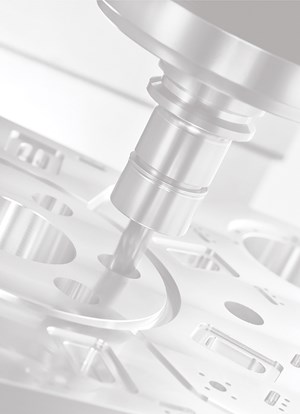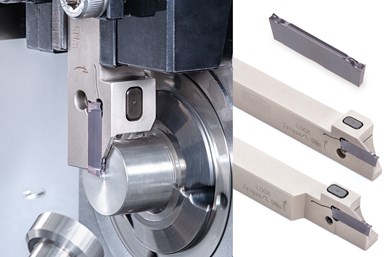Tungaloy's Grooving Inserts Reduce Waste From Parting-off
The new 1.2 mm-wide (.047″-wide) grooving inserts can reduce the material waste produced by parting-off by up to 40% when compared with using 2.0 mm-wide (.079″-wide) insert.
Share



Tungaloy has added 1.2 mm-wide (.047″-wide) DGS-style grooving inserts to its TungCut multifunctional grooving system.
According to Tungaloy, job shops that are mass-producing small parts with Swiss lathes can save costs by minimizing material waste in the part-off process. New 1.2 mm-wide (.047″-wide) grooving inserts can reduce the material waste produced by parting-off by up to 40% when compared with using 2.0 mm-wide (.079″-wide) insert. Tungaloy says this translates to, after 2,500 cuts, the saving of a 2,000 mm-long (78.74″ long) bar stock.
The new grooving inserts feature a DGS-style chipbreaker that generates smooth cutting and excellent chip evacuation. In combination with versatile AH725 grade, the insert reportedly ensures stable parting-off performances in a range of material groups.
The toolholders, which are designed for use on Swiss machines, are available in 10 × 10, 12 × 12, or 16 × 16 mm shanks. The insert is securely clamped in the seat by operating the screw located on the side of the holder, enabling the insert to be changed while the toolholder is still in the machine. This enables insert change time to be reduced to one third of the time conventional Swiss toolholders would require, significantly shortening machine downtime.
In addition, toolholders designed for the machines with the sub-spindle are also available, aside from standard style toolholders. Tungaloy says this ensures stable operation when parting off a short workpiece close to the chuck.
Related Content
-
Through-Coolant System Cuts Nickel-Alloy Cycle Times by 70%
Decker Machine Works recently adopted Rego-Fix’s reCool through-coolant system for ER collets, reducing the cycle times on a nickel alloy job by 70%.
-
PowRgrip Responds to Three Tooling Trends
Rego-Fix’s PowRgrip tooling system has expanded over the past 20 years to incorporate a wider range of tool sizes, as well as automation.
-
Rego-Fix Toolholder Enables Aggressive Turning Operations
The PG48 toolholder is designed for large-diameter tools and dynamic machining applications.























